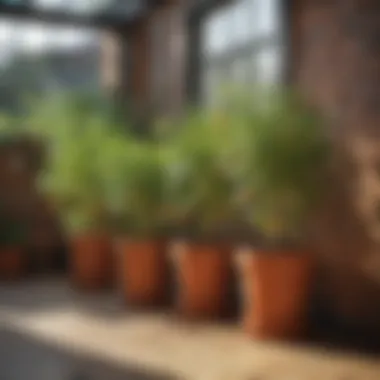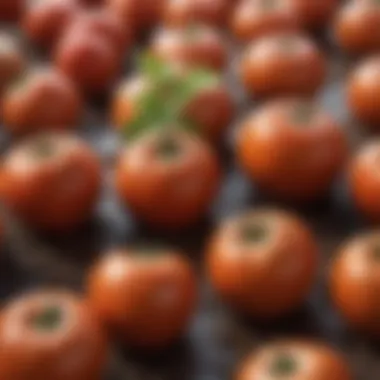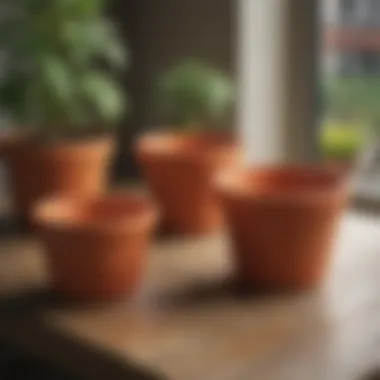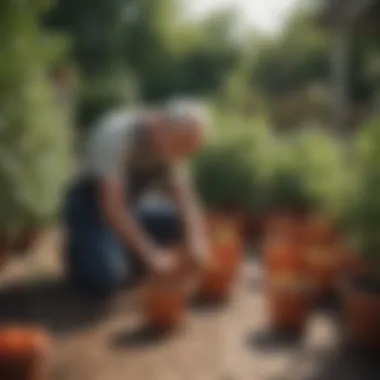The Definitive Guide to Plastic Tomato Pots


Intro
Plastic tomato pots have become a popular choice among gardeners for various reasons. Their lightweight nature, versatility, and ease of use make them suitable for both novice and seasoned cultivators. This article aims to examine the design, advantages, and disadvantages of plastic tomato pots, providing essential insights for effective gardening. By understanding the implications of using these pots, readers will be better equipped to enhance their gardening experiences and achieve optimal growth for their plants.
Design Inspiration
When selecting plastic tomato pots, the design can largely influence functionality and aesthetics. The right style can enhance the overall look of a garden or patio while also providing practical benefits for plant growth.
Trending Styles
Current trends in gardening emphasize minimalism and practicality. Many plastic pots come in sleek, contemporary designs. Some pots have added features like built-in drainage and self-watering capabilities. This function promotes healthier root systems by preventing waterlogged soil. Additionally, pots shaped like traditional terracotta ones are gaining traction. This design appeals to those who prefer a more classic look for their gardening needs.
Color Palettes
The color of plastic tomato pots also plays a vital role in gardening aesthetics. Neutral colors such as whites, greys, and browns are popular among gardeners aiming for a clean and sophisticated design. Conversely, brighter colors can add vibrancy to the garden. Green or deep reds, for instance, can encourage a lush visual appeal. When selecting pot colors, consider your overall garden theme to ensure a cohesive look.
Practical Tips
Successfully utilizing plastic tomato pots requires certain strategies. Here are some effective practical tips for optimal usage.
Maintenance & Care
Maintaining plastic pots involves simple yet essential practices. Regular cleaning is crucial to prevent algae buildup and disease spread. Use a gentle soap solution and a soft brush to clean the pots. Avoid harsh chemicals as they can harm the plants. Additionally, check for cracks or fading in the plastic regularly. Replacing damaged pots will ensure that plants remain secure.
Budgeting & Planning
Budgeting for plastic tomato pots should include a consideration of the types and quantities needed. While cheaper pots may seem appealing, investing in high-quality ones will lead to better durability and performance. It is wise to plan your gardening space accordingly, considering the growth potential of your plants. Allocate more funds for pots that provide additional functionalities, such as self-watering designs.
"The choice of your pots can significantly impact plant growth and garden aesthetics. Consider both style and function when making selections."
In summary, understanding the advantages and design options of plastic tomato pots can enhance your gardening experience. The right choice can lead to thriving plants and an appealing outdoor space. This guide aims to equip you with the knowledge necessary for informed decisions in your gardening journey.
Foreword to Plastic Tomato Pots
Understanding the role of plastic tomato pots is essential for any gardening enthusiast. These pots have gained popularity due to their accessibility and versatility in various gardening practices. They are especially favored by homeowners and gardeners looking to cultivate tomatoes with minimal complication.
Defining Plastic Tomato Pots
Plastic tomato pots are specifically designed containers made from durable polymers suitable for growing tomato plants. They come in various sizes and shapes, providing options for different types of gardeners. The lightweight nature of these pots makes them easy to transport, ideal for those who like to rearrange their gardens or move plants indoors during colder months. The design typically includes drainage holes to prevent water from accumulating, which is critical for the health of the plants. This simple design feature significantly reduces the risk of root rot, which is a common issue faced by many tomato growers.
The Impact of Material Choices in Gardening
Choosing the right materials for planting is crucial, as it directly affects plant health. Plastic pots can vary in quality, from those made of recycled materials to those crafted from virgin plastics. Each type offers distinct advantages and disadvantages. For instance, high-quality plastic pots are lightweight, resistant to breaking, and can last several seasons. However, lower-grade plastics may degrade over time, leading to leakage and reduced functionality.
Moreover, the environmental aspects of plastic are a growing concern. Gardeners should consider the sustainability of their choices. Opting for biodegradable options or pots made from recycled materials may reduce ecological footprints. There is also a growing interest in pots designed for air pruning, which can enhance plant growth by encouraging healthier root systems. This is becoming a significant consideration for modern gardening enthusiasts looking to make informed decisions that align with eco-friendly practices.
"Choosing the right pot material is integral to achieving successful plant growth. Understanding these implications can lead to more sustainable gardening practices."
In summary, plastic tomato pots serve as practical tools in gardening. They cater to a wide range of gardeners, balancing functionality, affordability, and availability. As we proceed through this guide, we will explore their advantages, disadvantages, and optimal usage scenarios.
Advantages of Plastic Tomato Pots
The use of plastic tomato pots comes with a range of benefits that can greatly enhance the gardening experience. These advantages are important for any gardener to consider when selecting pots for growing tomatoes. Factors such as lightweight nature, durability, and cost-effectiveness all contribute to making plastic tomato pots a popular choice.
Lightweight and Portable
One of the most significant advantages of plastic tomato pots is their lightweight structure. Unlike pots made from ceramic or terracotta, plastic pots are easy to handle. This quality is especially relevant for those who may need to rearrange their garden frequently or move plants indoors during harsh weather conditions. For example, a gardener wishing to protect their tomato plants from frost can move plastic pots indoors without straining. The convenient weight allows for flexibility in planting arrangements, ensuring that gardeners have more freedom in their gardening plans.


Durability and Longevity
Plastic tomato pots are built to last. They withstand various weather conditions, from intense sunlight to heavy rain. This durability means that they do not easily crack or break, unlike their ceramic counterparts. Moreover, they resist rust and decay, maintaining their integrity over time. Durable materials like high-density polyethylene contribute significantly to this longevity. By investing in plastic pots, gardeners can rely on them for several growing seasons, making them a wise choice for long-term use.
Affordability
In addition to their lightweight and durable nature, plastic tomato pots are typically more affordable than other types of pots. Gardening can be a costly endeavor, and managing expenses is crucial. Plastic pots tend to be less expensive to manufacture, allowing many retailers to offer them at competitive prices. This affordability means that gardeners, whether novices or experienced, can equip themselves with the necessary pots without overspending. Investing in budget-friendly pots allows for more resources to be allocated toward other gardening needs, such as soil amendments or seeds.
"Plastic pots can be a gardener's best investment, combining usefulness with cost efficiency."
Disadvantages of Plastic Tomato Pots
Plastic tomato pots offer convenience, but they come with certain drawbacks that gardeners should consider before deciding on their use. Understanding these disadvantages is crucial for making informed decisions that can affect the health of plants and environmental sustainability. This section highlights the key concerns related to the environmental impact, heat retention, and potential chemical leaching associated with plastic pots.
Environmental Considerations
One of the foremost concerns regarding plastic tomato pots is their environmental impact. Plastic is a synthetic material that can take hundreds of years to decompose. As gardeners, it's essential to recognize that the use of plastic contributes to waste and pollution in our ecosystems.
Many plastics used in pots, such as polyethylene and polypropylene, are derived from fossil fuels. Their production process not only emits greenhouse gases but also consumes energy and resources that could be utilized elsewhere.
According to recent studies, the recycling rate for plastic in general is low, which means a significant portion ends up in landfills. Thus, gardeners should carefully weigh the convenience of using plastic pots against the long-term effects on the environment.
Heat Retention Issues
Heat retention is another significant drawback of plastic pots. They tend to absorb and retain heat more than other materials such as clay or ceramic. In hot climates, this can lead to excessively high soil temperatures, which are detrimental to plant roots. Higher soil temperatures can induce stress and hinder plant growth, ultimately affecting yields.
If not managed properly, these conditions can lead to a greater need for watering to maintain soil moisture, thereby casting doubt on the overall sustainability of using plastic pots in certain environments. The need for more frequent irrigation can increase labor costs and water usage, counterproductive to environmental goals.
Potential Chemical Leaching
Lastly, there is concern about potential chemical leaching from plastic pots into the soil. Some plastics can contain harmful additives or stabilizers that may migrate into the soil, especially when exposed to heat and sunlight. This is a pressing concern for gardeners focused on organic practices or those growing food crops like tomatoes.
Chemical leaching poses risks to both plant health and the safety of edible produce. Therefore, it's advisable for gardeners to remain vigilant about the types of plastic used in their growing containers. Choosing high-quality, BPA-free plastics can mitigate some of these risks, but it does not eliminate them entirely.
Sustainability should always be at the forefront of gardening practices. By weighing these disadvantages against the advantages, gardeners can make conscious choices that align with their values regarding the environment and plant health.
Choosing the Right Plastic Tomato Pot
Selecting the appropriate plastic tomato pot can have a significant impact on the growth and yield of your plants. This section evaluates essential factors that influence the decision-making process, including size, design features, and cost considerations. Understanding these elements will enhance the gardening experience and optimize the health of the tomato plants.
Size Considerations
The size of the container plays a crucial role in tomato cultivation. A pot that is too small will restrict root growth and limit the plant's potential. Conversely, an oversized pot can lead to excessive moisture retention, which could subsequently cause root rot. Generally, a pot with a diameter of at least 5 gallons is recommended for tomato plants, particularly indeterminate varieties.
Here are key points about size:
- Root Space: Adequate space allows roots to spread, accessing nutrients and water efficiently.
- Surface Area: Larger pots provide more surface area for soil and thus for moisture retention.
- Weight Considerations: Ensure that the size is practical for handling, especially if you need to move the pots around.
Pot Design and Features
When considering pot design, several features come into play that can enhance or hinder the plant's growth and ease of care. The following elements are significant:
Drainage Holes
Proper drainage is critical in preventing waterlogged soil, which is detrimental to tomato plants. Drainage holes allow excess water to escape, reducing the risk of root rot and promoting healthier growth.
- Key Characteristic: Adequate holes help maintain the right moisture level.
- Benefit: Ensures roots are not submerged in water, promoting air growth.
- Advantage: Easy to create and maintain.


Handles for Mobility
Handles on pots offer convenience, allowing easy movement. This feature is particularly useful for gardeners who may need to shift pots due to changes in sunlight or space.
- Key Characteristic: Sturdy handles improve grip and control.
- Benefit: Facilitates relocation without stress on the plant.
- Advantage: Especially beneficial in small gardens or balconies where space is limited.
Aeration Features
Some plastic pots come equipped with design elements that enhance aeration. These may include perforated walls or aeration holes. Adequate aeration improves root oxygenation, essential for healthy plant growth.
- Key Characteristic: Ensures roots receive sufficient oxygen.
- Benefit: Reduces the chances of overwatering due to improved water drainage.
- Advantage: Can lead to a healthier plant overall.
Cost vs. Quality Analysis
While it may be tempting to choose the cheapest option available, this can lead to unexpected issues down the line. Performance should be weighed alongside price. Higher quality pots may cost more initially, but they often last longer, withstand outdoor conditions, and perform better for plants.
- Material Durability: Assess the longevity of the materials used. UV resistance and weatherproofing offer added value.
- Investment for Growth: Consider this purchase as an investment in plant health.
- Reviews and Recommendations: Look for feedback on specific brands.
Optimal Use of Plastic Tomato Pots
Understanding the optimal use of plastic tomato pots is crucial for achieving successful gardening outcomes. Plastic tomato pots are versatile tools in your gardening toolkit. They can be used effectively for various plants beyond tomatoes. Using these pots correctly enhances your success, increases plant health, and can lead to better yields. Here we will explore essential aspects like soil and drainage, watering practices, and proper fertilization. Each element plays a significant role in ensuring that the plants thrive in these unique containers.
Soil and Drainage Requirements
The choice of soil and the provision of adequate drainage are fundamental to the use of plastic tomato pots. First, it's vital to select a high-quality potting mix. This mix often contains peat moss, compost, and perlite, which offers good aeration and nutrients. An appropriate blend helps retain moisture while preventing root rot.
Next comes drainage. Plastic pots, unlike terracotta or other materials, can easily be susceptible to overwatering. Without proper drainage, excess water can sit at the bottom, causing plant roots to drown. To counter this:
- Ensure that your pots have sufficient drainage holes.
- Elevate pots slightly off the ground to promote airflow
- Place gravel or small stones at the base of the pot before adding soil to facilitate drainage.
Managing these soil and drainage needs effectively can lead to healthier plants that produce satisfactory yields.
Watering Practices
Watering is another critical aspect of using plastic tomato pots. The lightweight nature of these pots means they can dry out quicker than heavier materials. Therefore, a consistent watering schedule is necessary. However, you must avoid overwatering, which poses its own risks, particularly in plastic containers.
To achieve optimal watering:
- Check the soil moisture regularly. A finger inserted into the soil can help assess its dampness.
- Water thoroughly until you see it drain through the holes at the pot's bottom. This process ensures that the roots get evenly supplied with water.
- Consider using self-watering systems or watering spikes if you travel frequently. These systems can help maintain moisture levels and ensure plants do not dry out.
Fertilization and Nutrient Management
Fertilization is pivotal for maintaining the nutritional needs of plants grown in plastic pots. Since the soil in containers tends to deplete nutrients faster due to limited volume, regular fertilization is essential. Here are some steps to consider:
- Use a balanced, slow-release fertilizer when planting. This helps establish initial growth.
- As the plants mature, switch to liquid fertilizers for a more immediate nutrient boost. This can occur every two to four weeks, depending on the growth stage.
- Monitor your plants closely. Signs of nutrient deficiency include yellowing leaves or stunted growth. Adjust your fertilization frequency and type based on these observations.
Maintenance of Plastic Tomato Pots
Proper maintenance of plastic tomato pots ensures their longevity, efficiency, and overall usability in gardening. By adopting suitable habits, gardeners can enhance the utility of these containers, prevent disease, and promote optimal growth of their plants. Here, we will explore essential components for maintaining plastic tomato pots and ultimately maximizing gardening success.
Cleaning and Sanitizing
Cleaning and sanitizing plastic tomato pots are crucial practices that cannot be overlooked. Over time, dirt, plant residues, and pests can accumulate, creating an environment conducive to disease. To maintain healthy plants, gardeners should perform regular cleanings.
- Rinse Pots Regularly: After each use, rinse the pots with water to remove soil and residues. This step helps reduce the risk of cross-contamination from previous plants.
- Use Mild Soap: For deeper cleaning, a solution of mild soap and water can be applied to scrub pots thoroughly. Ensure that all surfaces are scrubbed, especially hard-to-reach areas.
- Sanitize After Use: After cleaning, use a sanitizing solution such as a diluted bleach or hydrogen peroxide solution. Let the pots soak for a few minutes, then rinse them well to eliminate any remaining residue.
By keeping pots clean, it enhances the performance of the growing environment and minimizes challenges like root rot or disease spread.


Storage Techniques
Proper storage techniques play a significant role in maintaining plastic tomato pots when not in use. Storing pots correctly can protect them from environmental hazards and prolong their life.
- Indoor Storage: If possible, store plastic pots indoors in a cool, dry place. This avoids exposure to excessive UV light and temperature variations that can degrade the material.
- Stacking Pots: When pots are empty, they can often be nested or stacked. Ensure that they are dry before stacking to prevent mold growth.
- Cover When Outdoors: If storage indoors is not feasible, consider covering them with a tarp or plastic sheeting. This action shields the pots from harsh weather conditions.
- Check Periodically: Regularly inspect stored pots for signs of damage or pests. Quick action can prevent larger problems.
Repair and Recycling Options
Maintaining plastic tomato pots often involves knowing how to repair or recycle them. Understanding these options is essential for eco-friendly practices in gardening.
- Repairing Cracks: Small cracks can be repaired with a strong adhesive or plastic epoxy. Ensure the area is clean before applying adhesive to achieve the best bond.
- Recycling: If a pot is beyond repair, recycling is an environmentally responsible choice. Many recycling centers accept plastic planters. Be sure to check local guidelines to recycle appropriately.
- Repurposing Options: Consider repurposing old pots for other gardening projects. They can become great storage containers for tools, smaller indoor plants, or even hold compost materials.
Sustainability and Environmental Impact
Sustainability is a critical aspect when considering the use of plastic tomato pots in gardening. The ongoing discourse about environmental impact underscores the need for gardeners to evaluate their choices carefully. As awareness of climate change grows, understanding the implications of plastic in gardening practices becomes necessary. The discussion here will focus on eco-friendly alternatives and the role of plastic in modern gardening.
Eco-Friendly Alternatives
Although plastic tomato pots offer certain advantages, their environmental footprint cannot be ignored. There are various eco-friendly alternatives that gardeners can consider. Some options are:
- Biodegradable Pots: Made from materials like peat, bamboo, or recycled paper, these pots break down naturally over time, enriching the soil as they decompose.
- Fabric Pots: Often made from recycled materials, they allow for better aeration and drainage. They are durable, reusable, and can be recycled at the end of their life cycle.
- Ceramic or Clay Pots: While heavier than plastic, these pots have a natural aesthetic. They can stabilize temperature better than plastic, providing beneficial conditions for root health.
- Recycled Plastics: Some manufacturers create pots from recycled materials, reducing the demand for new plastics and helping to minimize waste.
These alternatives can lessen the environmental burden while still allowing for effective gardening practices. However, each option comes with its own set of advantages and limitations, which must be considered for impactful gardening.
The Role of Plastic in Modern Gardening
Plastic has undoubtedly transformed the landscape of modern gardening. It provides several unique benefits that make it a common choice among gardeners. Understanding its role is key to framing a balanced perspective.
- Cost-Effectiveness: Plastic pots are typically less expensive than alternatives, making them widely accessible for many gardeners.
- Versatility: They come in various shapes, sizes, and colors. This variety allows gardeners to select pots that suit their specific needs or aesthetic preferences.
- Weather Resistance: Unlike some materials, plastic is resistant to rot, rust, and decay. This can prolong the lifespan of pots significantly, reducing the frequency of replacements.
While the practicality of plastic cannot be overlooked, it is important to recognize its potential drawbacks. The sustainability debate encourages gardeners to align their practices with eco-friendly principles, thus making conscientious choices.
"Understanding the balance between functionality and sustainability is vital for today's gardeners."
Trends in Gardening with Plastic Tomato Pots
The gardening world is constantly evolving. Plastic tomato pots are at the forefront of these changes. Understanding current trends can offer insights into better gardening practices. With innovations in both material and technology, gardeners can enhance their experiences and outcomes.
Innovative Designs in Materials
Recent years have seen a shift toward more eco-friendly materials. Many manufacturers are now producing plastic pots that incorporate recycled materials. This approach not only reduces waste but also lowers reliance on virgin plastic. Some premium designs even feature biodegradable elements. These designs cater to the environmentally-conscious gardener, promoting a sustainable gardening culture.
Another trend is the development of breathable or porous plastic. Traditional plastic pots often create issues related to root suffocation. New materials help combat this problem by allowing air and moisture exchange. Such innovations foster healthier root systems, leading to better growth and yield. As a gardener, it is important to recognize these advancements. Opting for pots with improved aeration can result in healthier plants.
"The evolution of materials in gardening tools is as essential as the plant choices themselves."
Integration with Smart Gardening Technologies
Technology is making significant strides in gardening. The integration of smart systems with plastic tomato pots is a growing trend. For example, pots equipped with sensors provide real-time data about soil moisture levels. This information helps gardeners optimize watering routines and prevent overwatering.
Moreover, some pots connect to smartphone applications. This integration allows for detailed monitoring of plant health and growth conditions. Gardeners can receive notifications about watering schedules, nutrient management, and pest control. Such innovations simplify the gardening process, making it more accessible to both beginners and seasoned gardeners.
The rise in automated solutions is noteworthy. Automated watering systems that can be controlled remotely are increasingly popular. These systems ensure plants receive the right amount of water at the right times. When combined with smart plastic pots, they represent a major step forward in efficiency.
Overall, the current trends in plastic tomato pots reflect a blend of sustainability and technology. Embracing these advancements can significantly enhance gardening practices, benefiting both the environment and the gardener.
End
In assessing the value of plastic tomato pots, it becomes clear that certain elements hold significant importance. This article addresses critical factors such as usage, benefits, drawbacks, and maintenance practices. Each aspect discussed contributes to a more profound understanding of how plastic pots fit within the broader gardening landscape.
Recapitulating the Key Points helps to reinforce essential information. Plastic tomato pots are lightweight, durable, and cost-effective. However, they have disadvantages related to environmental impact and potential chemical leaching. These considerations should inform the selection process, guiding gardeners in optimizing their gardening experience, especially in cultivating tomatoes effectively.
The section on Future Outlook explores how innovation in materials and technologies may evolve the use of plastic pots. As sustainability becomes a priority, manufacturers may enhance designs focusing on biodegradability, while integrating smart gardening features. Overall, understanding these trends can enable gardeners to adopt best practices that align with emerging values in gardening.















